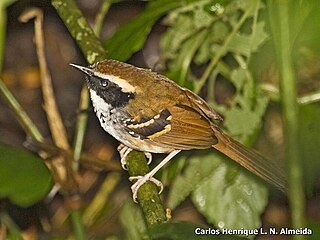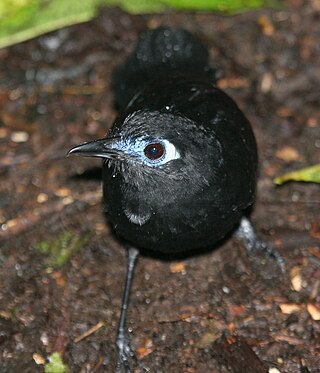
The white-bellied antbird, is a passerine bird which breeds in the tropical New World from Panama to northern Brazil and in Trinidad. It is also called Swainson's antcatcher after William John Swainson, who first described it scientifically. The genus is monotypic.

The chestnut-backed antbird is a passerine bird in subfamily Thamnophilinae of family Thamnophilidae, the "typical antbirds". It is found in Colombia, Costa Rica, Ecuador, Honduras, Nicaragua, and Panama.

The bicolored antbird is a species of bird in subfamily Thamnophilinae of family Thamnophilidae, the "typical antbirds". It is found in Colombia, Costa Rica, Ecuador, Honduras, Nicaragua, and Panama.

The stub-tailed antbird is a species of bird in subfamily Thamnophilinae of family Thamnophilidae, the "typical antbirds". It is found in Colombia and Ecuador.

The northern chestnut-tailed antbird, or Zimmer's antbird, is a species of bird in subfamily Thamnophilinae of family Thamnophilidae, the "typical antbirds". It is found in Colombia, Ecuador, and Peru.

The Yapacana antbird is a species of passerine bird in subfamily Thamnophilinae of family Thamnophilidae, the "typical antbirds". It is found Brazil, Colombia, and Venezuela.

The ferruginous-backed antbird is a species of passerine bird in subfamily Thamnophilinae of family Thamnophilidae, the "typical antbirds". It is found in Brazil, French Guyana, Guyana, Suriname, and Venezuela.

The grey-headed antbird is a Vulnerable species of bird in subfamily Thamnophilinae of family Thamnophilidae, the "typical antbirds". It is found in Ecuador and Peru.

The southern chestnut-tailed antbird, or chestnut-tailed antbird, is a species of passerine bird in subfamily Thamnophilinae of family Thamnophilidae, the "typical antbirds". It is found in Bolivia, Brazil, and Peru.

The dull-mantled antbird is a perching bird species in subfamily Thamnophilinae of family Thamnophilidae, the "typical antbirds". It is found in Colombia, Costa Rica, and Panama.

The white-bibbed antbird is a species of passerine bird in subfamily Thamnophilinae of family Thamnophilidae, the "typical antbirds". It is endemic to Brazil.

The Esmeraldas antbird is a species of bird in subfamily Thamnophilinae of family Thamnophilidae, the "typical antbirds". It is found in Colombia and Ecuador.

The grey-bellied antbird is a species of passerine bird in subfamily Thamnophilinae of family Thamnophilidae, the "typical antbirds". It is found Brazil, Colombia, and Venezuela.

The scalloped antbird is an Endangered species of passerine bird in subfamily Thamnophilinae of family Thamnophilidae, the "typical antbirds". It is endemic to Brazil.

The ocellated antbird is a species of antbird in subfamily Thamnophilinae of family Thamnophilidae, the "typical antbirds". It is found in Colombia, Costa Rica, Ecuador, Honduras, Nicaragua, and Panama.

The Caura antbird is a species of bird in subfamily Thamnophilinae of family Thamnophilidae, the "typical antbirds". It is found in Brazil and Venezuela.

The rufous-faced antbird is a species of bird in subfamily Thamnophilinae of family Thamnophilidae, the "typical antbirds". It is endemic to Brazil.

The Roraiman antbird is a species of passerine bird in subfamily Thamnophilinae of family Thamnophilidae, the "typical antbirds". It is found in Brazil, Guyana, and Venezuela.

Zeledon's antbird is a species of antbird in the family Thamnophilidae. It is found at low levels in humid forests from Nicaragua to Panama, and in the Chocó of western Colombia and western Ecuador. Zeledon's antbird feeds on insects, and regularly follows swarms of army ants in order to catch prey flushed by the swarms, but it is not an obligate ant-follower like some species of antbirds.

Sipia is a genus of passerine birds in the family Thamnophilidae.






















